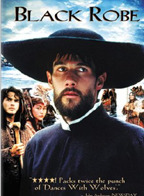 In 1634 New France (Quebec), Jesuit Father Laforgue, a young French missionary, is assigned to travel over 1500 miles to the Jesuit mission in a Huron settlement. Blackrobe, as the Indians call him, is accompanied by eight canoes of Algonquins and young French translator Daniel.
In 1634 New France (Quebec), Jesuit Father Laforgue, a young French missionary, is assigned to travel over 1500 miles to the Jesuit mission in a Huron settlement. Blackrobe, as the Indians call him, is accompanied by eight canoes of Algonquins and young French translator Daniel.
Black Robe has been recognized as one of the most authentic depictions of Indian life ever filmed. The architecture and detail of the housing, methods of hunting and what they ate are all based on historical investigations.
One thing I admired about Black Robe was the use of native languages. They did have the French speak English for the movie but otherwise the use of Native language (with English subtitles) added to the realism.
This movie had some similarities to Dances with Wolves. It was about the clash of cultures between the whites and the Indians. In this movie the main character, Father Laforgue, does his best to impress the Indians and tries to convert them to his culture and his religion. The young translator does see some merits in the native culture and does begin to "go native" as the movie goes on.
There are widely different portrayals of tribes in Black Robe. The Hurons and Algonquins are portrayed in a favorable light with strong cultures and values. The Iroquois are represented in a more savage manner.
Some of the reviewers for this movie have commented on how dark and hard to watch it was. I think the movie does a great job of representing what life was in that time period. I'd rather see realistic dark scenes than bright fantasy ones. In some periods of history, life was dark and brutish.
|